Page 1259 of 3419
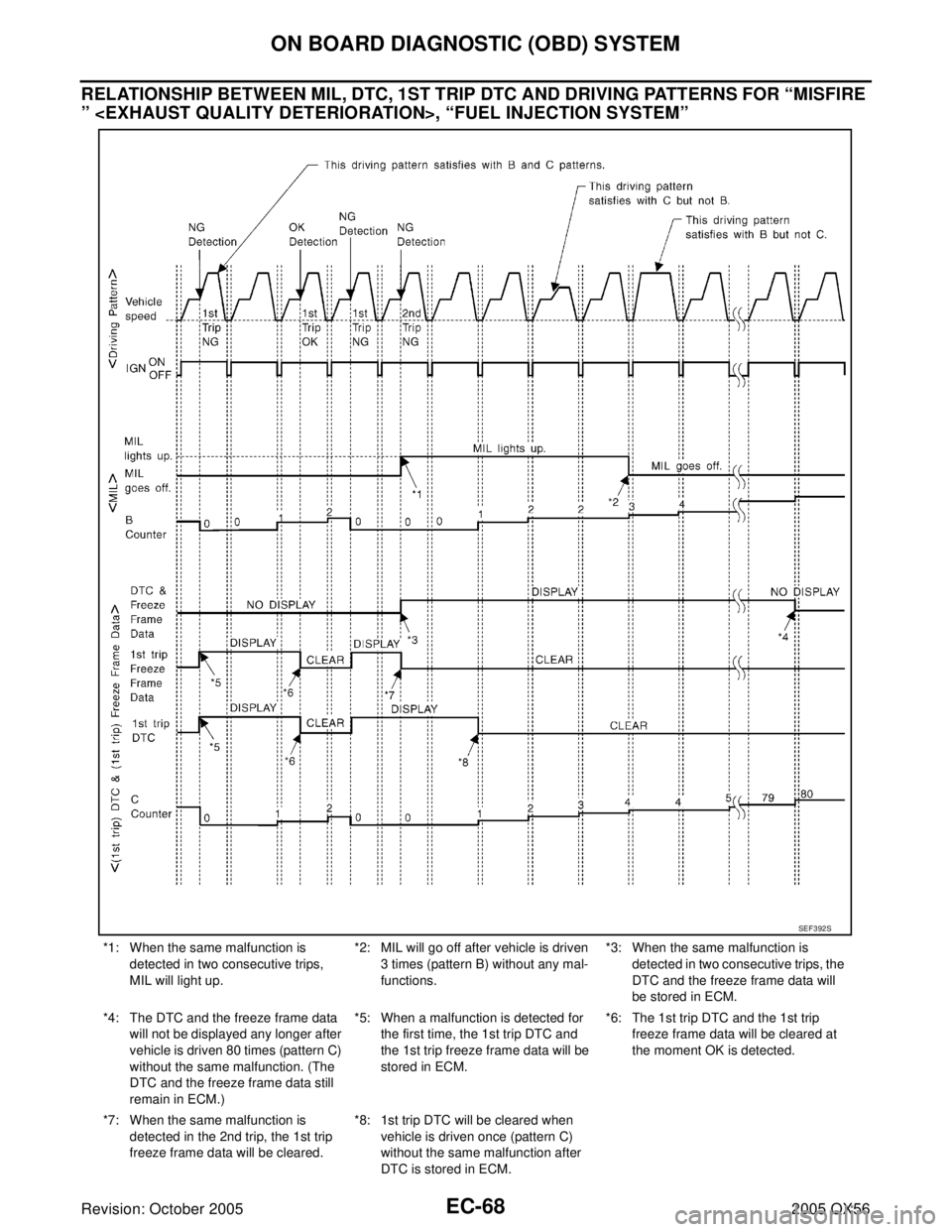
EC-68Revision: October 2005
ON BOARD DIAGNOSTIC (OBD) SYSTEM
2005 QX56
RELATIONSHIP BETWEEN MIL, DTC, 1ST TRIP DTC AND DRIVING PATTERNS FOR “MISFIRE
” , “FUEL INJECTION SYSTEM”
*1: When the same malfunction is
detected in two consecutive trips,
MIL will light up.*2: MIL will go off after vehicle is driven
3 times (pattern B) without any mal-
functions.*3: When the same malfunction is
detected in two consecutive trips, the
DTC and the freeze frame data will
be stored in ECM.
*4: The DTC and the freeze frame data
will not be displayed any longer after
vehicle is driven 80 times (pattern C)
without the same malfunction. (The
DTC and the freeze frame data still
remain in ECM.)*5: When a malfunction is detected for
the first time, the 1st trip DTC and
the 1st trip freeze frame data will be
stored in ECM.*6: The 1st trip DTC and the 1st trip
freeze frame data will be cleared at
the moment OK is detected.
*7: When the same malfunction is
detected in the 2nd trip, the 1st trip
freeze frame data will be cleared.*8: 1st trip DTC will be cleared when
vehicle is driven once (pattern C)
without the same malfunction after
DTC is stored in ECM.
SEF 3 92 S
Page 1260 of 3419

ON BOARD DIAGNOSTIC (OBD) SYSTEM
EC-69
C
D
E
F
G
H
I
J
K
L
MA
EC
Revision: October 20052005 QX56
EXPLANATION FOR DRIVING PATTERNS FOR “MISFIRE
TION>”, “FUEL INJECTION SYSTEM”
Driving pattern B means the vehicle operation as follows:
All components and systems should be monitored at least once by the OBD system.
�The B counter will be cleared when the malfunction is detected once regardless of the driving pattern.
�The B counter will be counted up when driving pattern B is satisfied without any malfunction.
�The MIL will go off when the B counter reaches 3. (*2 in “OBD SYSTEM OPERATION CHART”)
Driving pattern C means the vehicle operation as follows:
The following conditions should be satisfied at the same time:
Engine speed: (Engine speed in the freeze frame data) ±375 rpm
Calculated load value: (Calculated load value in the freeze frame data) x (1±0.1) [%]
Engine coolant temperature (T) condition:
�When the freeze frame data shows lower than 70°C (158°F), T should be lower than 70°C (158°F).
�When the freeze frame data shows higher than or equal to 70°C (158°F), T should be higher than or equal
to 70°C (158°F).
Example:
If the stored freeze frame data is as follows:
Engine speed: 850 rpm, Calculated load value: 30%, Engine coolant temperature: 80°C (176°F)
To be satisfied with driving pattern C, the vehicle should run under the following conditions:
Engine speed: 475 - 1,225 rpm, Calculated load value: 27 - 33%, Engine coolant temperature: more than 70°C
(158°F)
�The C counter will be cleared when the malfunction is detected regardless of vehicle conditions above.
�The C counter will be counted up when vehicle conditions above is satisfied without the same malfunction.
�The DTC will not be displayed after C counter reaches 80.
�The 1st trip DTC will be cleared when C counter is counted once without the same malfunction after DTC
is stored in ECM.
Page 1261 of 3419
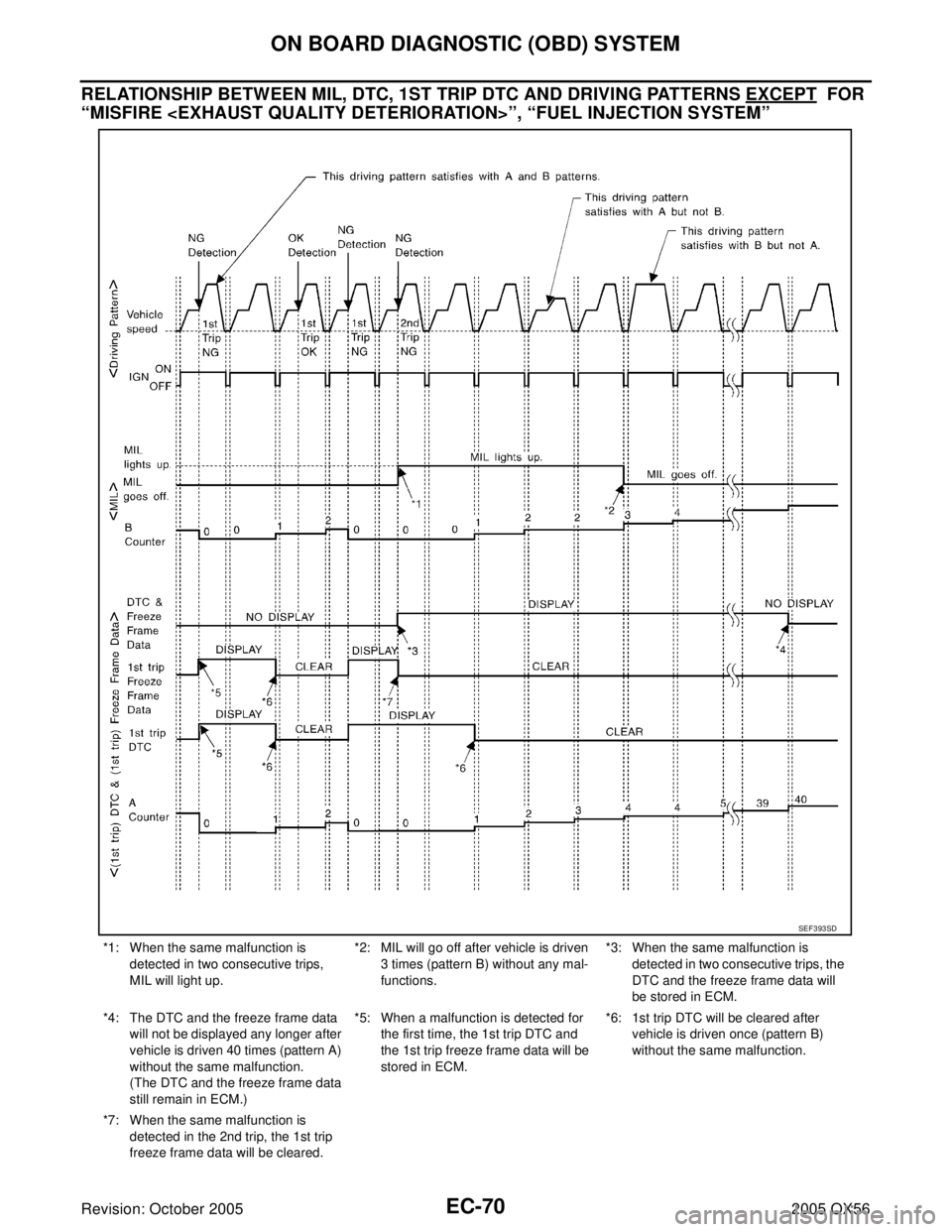
EC-70Revision: October 2005
ON BOARD DIAGNOSTIC (OBD) SYSTEM
2005 QX56
RELATIONSHIP BETWEEN MIL, DTC, 1ST TRIP DTC AND DRIVING PATTERNS EXCEPT FOR
“MISFIRE ”, “FUEL INJECTION SYSTEM”
*1: When the same malfunction is
detected in two consecutive trips,
MIL will light up.*2: MIL will go off after vehicle is driven
3 times (pattern B) without any mal-
functions.*3: When the same malfunction is
detected in two consecutive trips, the
DTC and the freeze frame data will
be stored in ECM.
*4: The DTC and the freeze frame data
will not be displayed any longer after
vehicle is driven 40 times (pattern A)
without the same malfunction.
(The DTC and the freeze frame data
still remain in ECM.)*5: When a malfunction is detected for
the first time, the 1st trip DTC and
the 1st trip freeze frame data will be
stored in ECM.*6: 1st trip DTC will be cleared after
vehicle is driven once (pattern B)
without the same malfunction.
*7: When the same malfunction is
detected in the 2nd trip, the 1st trip
freeze frame data will be cleared.
SEF 3 93 SD
Page 1262 of 3419
ON BOARD DIAGNOSTIC (OBD) SYSTEM
EC-71
C
D
E
F
G
H
I
J
K
L
MA
EC
Revision: October 20052005 QX56
EXPLANATION FOR DRIVING PATTERNS EXCEPT FOR “MISFIRE
DETERIORATION>”, “FUEL INJECTION SYSTEM”
�The A counter will be cleared when the malfunction is detected regardless of (1) - (4).
�The A counter will be counted up when (1) - (4) are satisfied without the same malfunction.
�The DTC will not be displayed after the A counter reaches 40.
Driving pattern B means the vehicle operation as follows:
All components and systems should be monitored at least once by the OBD system.
�The B counter will be cleared when the malfunction is detected once regardless of the driving pattern.
�The B counter will be counted up when driving pattern B is satisfied without any malfunctions.
�The MIL will go off when the B counter reaches 3 (*2 in OBD SYSTEM OPERATION CHART).
AEC5 74
Page 1263 of 3419
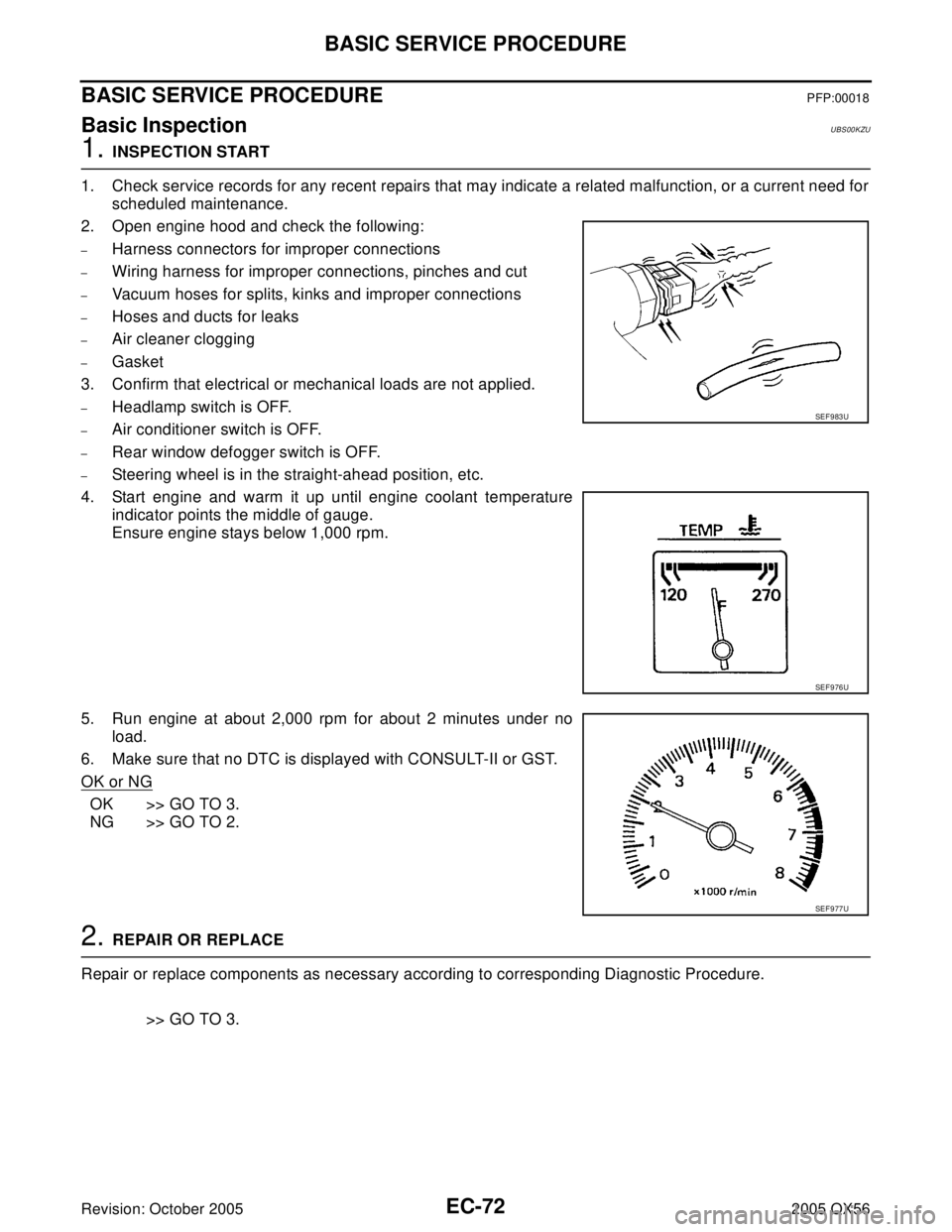
EC-72Revision: October 2005
BASIC SERVICE PROCEDURE
2005 QX56
BASIC SERVICE PROCEDUREPFP:00018
Basic InspectionUBS00KZU
1. INSPECTION START
1. Check service records for any recent repairs that may indicate a related malfunction, or a current need for
scheduled maintenance.
2. Open engine hood and check the following:
–Harness connectors for improper connections
–Wiring harness for improper connections, pinches and cut
–Vacuum hoses for splits, kinks and improper connections
–Hoses and ducts for leaks
–Air cleaner clogging
–Gasket
3. Confirm that electrical or mechanical loads are not applied.
–Headlamp switch is OFF.
–Air conditioner switch is OFF.
–Rear window defogger switch is OFF.
–Steering wheel is in the straight-ahead position, etc.
4. Start engine and warm it up until engine coolant temperature
indicator points the middle of gauge.
Ensure engine stays below 1,000 rpm.
5. Run engine at about 2,000 rpm for about 2 minutes under no
load.
6. Make sure that no DTC is displayed with CONSULT-II or GST.
OK or NG
OK >> GO TO 3.
NG >> GO TO 2.
2. REPAIR OR REPLACE
Repair or replace components as necessary according to corresponding Diagnostic Procedure.
>> GO TO 3.
SEF 9 83 U
SEF 9 76 U
SEF 9 77 U
Page 1272 of 3419
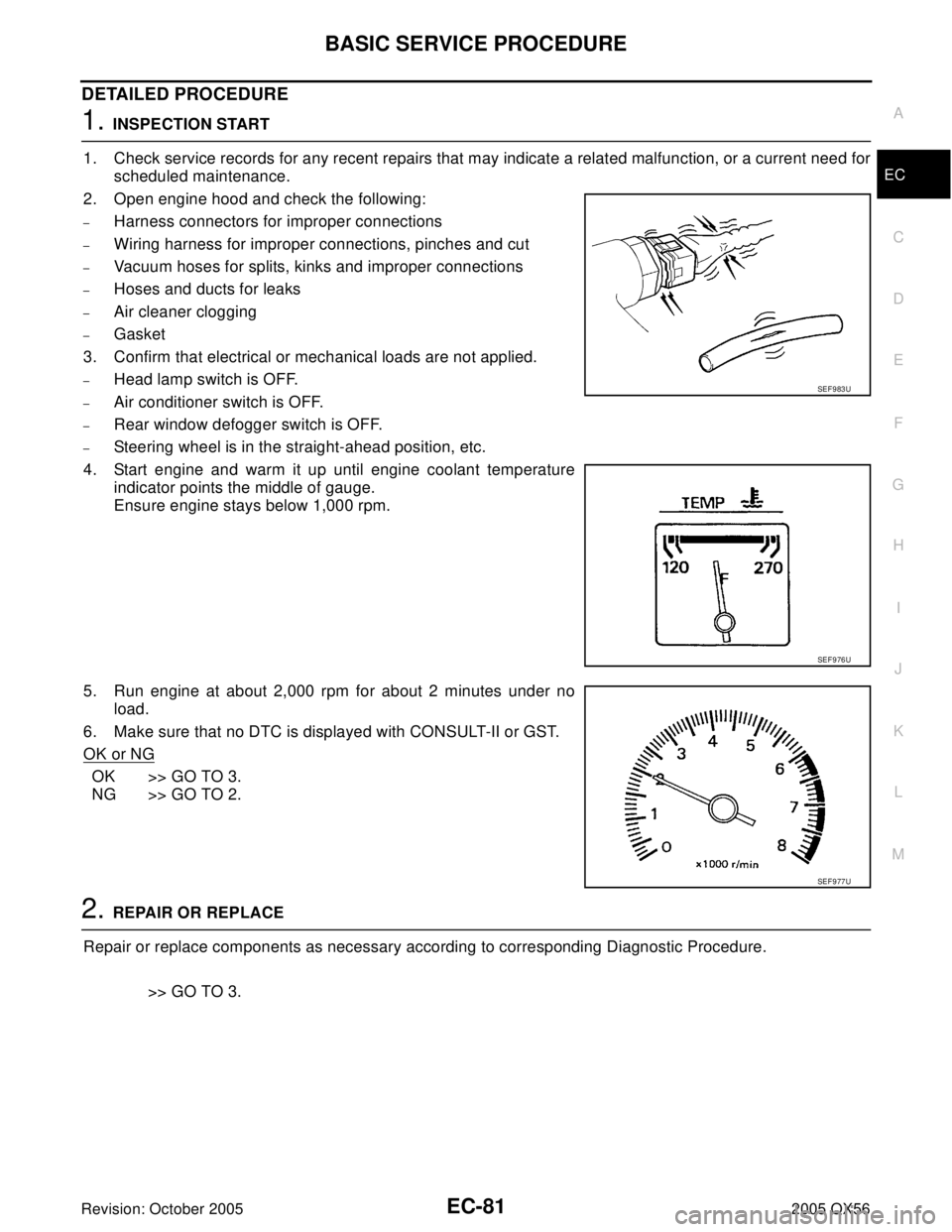
BASIC SERVICE PROCEDURE
EC-81
C
D
E
F
G
H
I
J
K
L
MA
EC
Revision: October 20052005 QX56
DETAILED PROCEDURE
1. INSPECTION START
1. Check service records for any recent repairs that may indicate a related malfunction, or a current need for
scheduled maintenance.
2. Open engine hood and check the following:
–Harness connectors for improper connections
–Wiring harness for improper connections, pinches and cut
–Vacuum hoses for splits, kinks and improper connections
–Hoses and ducts for leaks
–Air cleaner clogging
–Gasket
3. Confirm that electrical or mechanical loads are not applied.
–Head lamp switch is OFF.
–Air conditioner switch is OFF.
–Rear window defogger switch is OFF.
–Steering wheel is in the straight-ahead position, etc.
4. Start engine and warm it up until engine coolant temperature
indicator points the middle of gauge.
Ensure engine stays below 1,000 rpm.
5. Run engine at about 2,000 rpm for about 2 minutes under no
load.
6. Make sure that no DTC is displayed with CONSULT-II or GST.
OK or NG
OK >> GO TO 3.
NG >> GO TO 2.
2. REPAIR OR REPLACE
Repair or replace components as necessary according to corresponding Diagnostic Procedure.
>> GO TO 3.
SEF 9 83 U
SEF 9 76 U
SEF 9 77 U
Page 1277 of 3419

EC-86Revision: October 2005
BASIC SERVICE PROCEDURE
2005 QX56
19. CHECK AIR FUEL RATIO (A/F) SENSOR 1 FUNCTION
With CONSULT-II
1. Turn ignition switch OFF and wait at a least 10 seconds.
2. Start engine and warm it up to normal operating temperature.
3. Drive the vehicle at a speed of 80 km/h (50 MPH) for a few minutes in D position.
NOTE:
Keep the accelerator pedal as steady as possible during the cruising.
4. Release the accelerator pedal fully until the vehicle speed decreases to 50 km/h (30 MPH).
NOTE:
Never apply brake during releasing the accelerator pedal.
5. Repeat steps 3 to 4 for 5 times.
6. Stop the vehicle and connect CONSULT-II to the vehicle.
7. Make sure that no (1st trip) DTC is displayed in “SELF-DIAG RESULTS” mode.
OK or NG
OK >>INSPECTION END
NG >> GO TO 21.
20. CHECK AIR FUEL RATIO (A/F) SENSOR 1 FUNCTION
With GST
1. Turn ignition switch OFF and wait at a least 10 seconds.
2. Start engine and warm it up to normal operating temperature.
3. Drive the vehicle at a speed of 80 km/h (50 MPH) for a few minutes in D position.
NOTE:
Keep the accelerator pedal as steady as possible during the cruising.
4. Release the accelerator pedal fully until the vehicle speed decreases to 50 km/h (30 MPH).
NOTE:
Never apply brake during releasing the accelerator pedal.
5. Repeat steps 3 to 4 for 5 times.
6. Stop the vehicle and connect GST to the vehicle.
7. Make sure that no (1st trip) DTC is displayed.
OK or NG
OK >>INSPECTION END
NG >> GO TO 21.
Page 1280 of 3419
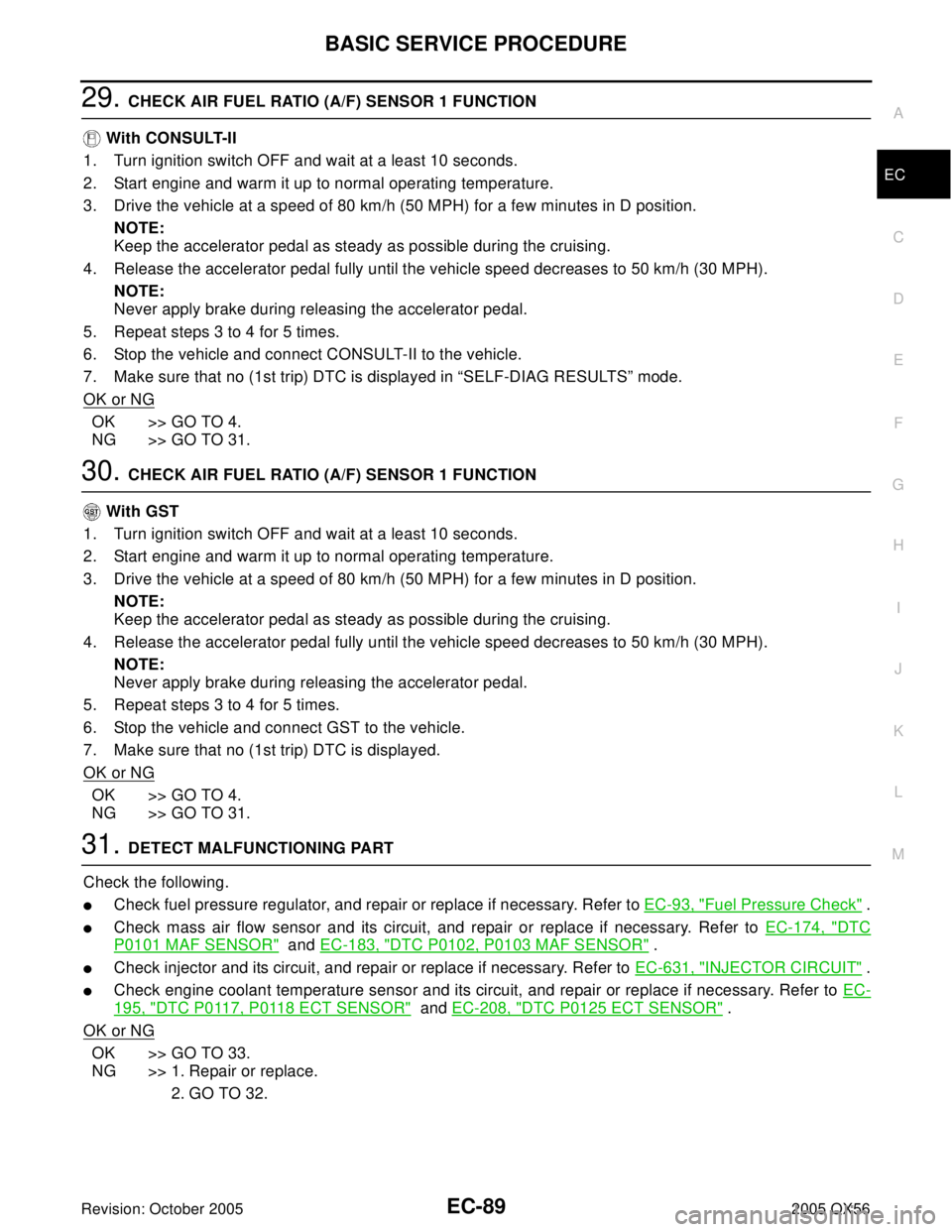
BASIC SERVICE PROCEDURE
EC-89
C
D
E
F
G
H
I
J
K
L
MA
EC
Revision: October 20052005 QX56
29. CHECK AIR FUEL RATIO (A/F) SENSOR 1 FUNCTION
With CONSULT-II
1. Turn ignition switch OFF and wait at a least 10 seconds.
2. Start engine and warm it up to normal operating temperature.
3. Drive the vehicle at a speed of 80 km/h (50 MPH) for a few minutes in D position.
NOTE:
Keep the accelerator pedal as steady as possible during the cruising.
4. Release the accelerator pedal fully until the vehicle speed decreases to 50 km/h (30 MPH).
NOTE:
Never apply brake during releasing the accelerator pedal.
5. Repeat steps 3 to 4 for 5 times.
6. Stop the vehicle and connect CONSULT-II to the vehicle.
7. Make sure that no (1st trip) DTC is displayed in “SELF-DIAG RESULTS” mode.
OK or NG
OK >> GO TO 4.
NG >> GO TO 31.
30. CHECK AIR FUEL RATIO (A/F) SENSOR 1 FUNCTION
With GST
1. Turn ignition switch OFF and wait at a least 10 seconds.
2. Start engine and warm it up to normal operating temperature.
3. Drive the vehicle at a speed of 80 km/h (50 MPH) for a few minutes in D position.
NOTE:
Keep the accelerator pedal as steady as possible during the cruising.
4. Release the accelerator pedal fully until the vehicle speed decreases to 50 km/h (30 MPH).
NOTE:
Never apply brake during releasing the accelerator pedal.
5. Repeat steps 3 to 4 for 5 times.
6. Stop the vehicle and connect GST to the vehicle.
7. Make sure that no (1st trip) DTC is displayed.
OK or NG
OK >> GO TO 4.
NG >> GO TO 31.
31. DETECT MALFUNCTIONING PART
Check the following.
�Check fuel pressure regulator, and repair or replace if necessary. Refer to EC-93, "Fuel Pressure Check" .
�Check mass air flow sensor and its circuit, and repair or replace if necessary. Refer to EC-174, "DTC
P0101 MAF SENSOR" and EC-183, "DTC P0102, P0103 MAF SENSOR" .
�Check injector and its circuit, and repair or replace if necessary. Refer to EC-631, "INJECTOR CIRCUIT" .
�Check engine coolant temperature sensor and its circuit, and repair or replace if necessary. Refer to EC-
195, "DTC P0117, P0118 ECT SENSOR" and EC-208, "DTC P0125 ECT SENSOR" .
OK or NG
OK >> GO TO 33.
NG >> 1. Repair or replace.
2. GO TO 32.